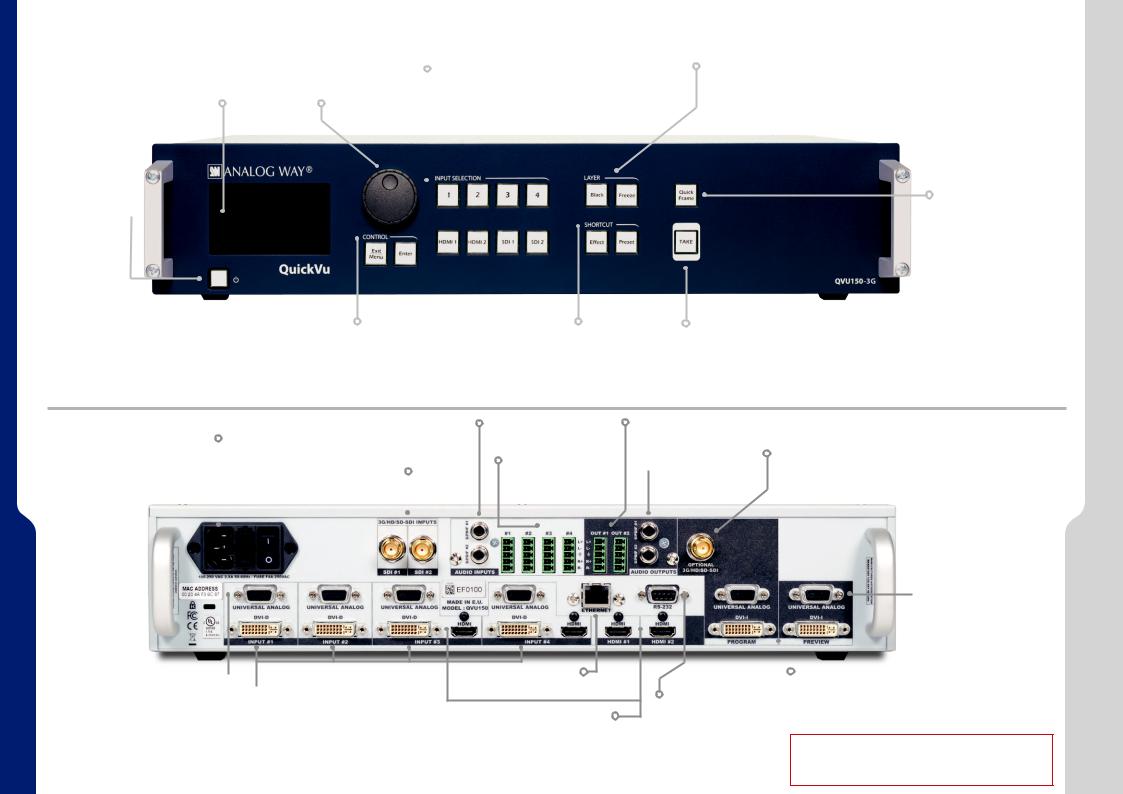Analog Way QVU150-3G Quick Start Guide

QUICK START GUIDE
QuickVu - Ref. QVU150-3G
Thank you for choosing Analog Way and the QuickVu. By following these simple steps, you will be able to set up and use your powerful Dual Scaler Hi-Resolution Seamless Switcher based on Analog Way’s Midra™ platformwithinminutes.DiscovertheQuickVu capabilitiesandintuitiveinterfacewhileconfiguringyourfirst show and unleash your creativity for a new experience in show and event management.
WHAT’S IN THE BOX |
CAUTION! |
• 1 x QuickVu (QVU150-3G) |
If required, front handles of the device can be dismantled, |
but with caution. The original screws removed must not |
|
• 1 x Power supply cord |
be reintroduced to their location without handles in place. |
• 1 x Ethernet cross cable (for device update) |
Substantial damages can occur, including risk of electric |
• 1 x Remote Control Software (RCS²)* |
shock from the mains voltage. Only M4x12mm screws can |
• 1 x Set of 6 audio 5-pin screw terminals |
be used. (They are supplied with the unit.) |
|
•1 x Front Rack Ears (the parts are stowed in the packaging foam)
•1 x User Manual (PDF)*
• 1 x Quick Start guide* |
Go on our website to register |
* User manual, quick start guide and the RCS² are available |
your product(s) and be notified |
about new firmware versions: |
|
on www.analogway.com |
http://bit.ly/AW-Register |
 QUICK INSTALL AND SETUP
QUICK INSTALL AND SETUP
Getting started:
You may wish to reset the unit to factory settings to get started. Go to: Menu > Control > Reset/Erase > Default
Values > Yes
1.Select the Output resolution that matches the native resolution of your display. You will next be prompted to choose enable follow mode if desired and output rate.
Menu > Output > Output format > 1920x1080 > Internal Ref > 60 Hz
2.Inputs can be configured automatically using the Auto Set All function. Menu > Intputs > AutoSet All > Yes
It will scan each input and detect the sync type that is plugged in. You can still do an Autoset or manual setup per
input.
The QuickVu has 3 layers available called: FRAME*, LAYER
A and QUICK FRAME.
*PleasenotethattheBackgroundFrameLayercan only be set with the RCS² or the RK-350 Remote Control Keypad.
3. To display a source, select a source (it will blink). Press TAKE to transition your source from Preview to Program output.
To view on Preview or change the contents of a different source, simply select it. Only 1 layer can be seen on the
Preview.
4. To clear the layer select BLACK. Press TAKE to remove the layer from the Program output.
TIP: If you would like the Program and Preview to toggle/ flipflop during each Take, enable this feature by going to
Menu > Control > Functions > Preset Toggle.
Once enabled, the old Program output will become the new Preview after each Take.
5. See the next page which describes the button lighting color code and other front panel features.
QuickVu can be used to display:
- sources seamlessly switched in the LAYER A.
IMPORTANT: Simply selecting a menu item will not set it to that value. Be sure to press the ENTER button when setting the menu items.

 QUICKVU-REF.QVU150-3G /FRONT&REAR PANELS DESCRIPTION
QUICKVU-REF.QVU150-3G /FRONT&REAR PANELS DESCRIPTION
Front panel display: |
Menu scroll |
Input selection: |
|
1 to 4: access source 1 to 4, |
|||
4-line VFD |
knob |
||
HDMI 1/2: access HDMI 1 or HDMI 2 |
|||
|
|
||
|
|
SDI 1 to SDI 2: access SDI 1 to SDI 2 |
|
|
|
|
On/Off Stand-by: Hold for 3 seconds for
Stand-by: Hold for 3 seconds for
stand-by mode
Control: |
Shortcut: |
Exit/Menu: Home menu |
Effect: shortcut to transition menu |
or back one level |
Preset: recall a custom stored preset |
Enter: validate the menu |
|
or command |
|
Layer:
Black: clear the output
Freeze: freeze the input linked to the current layer on Program
TAKE:
Transition the pre-selected sources onto the Program output with the selected effects
Quick Frame: allows to quickly display a foreground Frame
|
|
|
S/PDIF: |
Power supply: |
inputs #1 to #2 |
||
100-240 VAC 2.5A 50/60HZ / |
|
|
|
FUSE F4A 250 VAC; internal, |
3G/HD/SD-SDI: |
||
autoswitchable; 110W |
inputs #1 to #2 |
|
|
|
|||
|
|
|
|
|
|
|
|
MCO male connector: for inputs (balanced) #1 to #4
Universal Analog
Computer/TV/HDTV:
inputs #1 to #4
 DVI connectors:
DVI connectors:
DVI-D inputs #1 to #4. Capability to receive digital audio signal from HDMI connector via an adaptator (HDMI-compatible)
Ethernet
Plug
HDMI connectors:
HDMI inputs #3 to #6.
Digital audio compliant
MCO male connector: for outputs (balanced) #1 to #2
 S/PDIF: outputs #1 to #2
S/PDIF: outputs #1 to #2
Communication port: communication port with a DB9 female connector
Video output connector:
1 x BNC-F: 3G/HD/SD-SDI (with audio embedded)
 Universal Analog Computer TV/HDTV: outputs #1 to #2
Universal Analog Computer TV/HDTV: outputs #1 to #2
 DVI connectors:
DVI connectors:
DVI-I outputs #1 to #2. Capability to transmit digital audio signal towards a HDMI connector via an adaptator (HDMI-compatible)
CAUTION:
Theusershould avoiddisconnectingthepowersource (AC input) until the unit is in stand-by mode.
